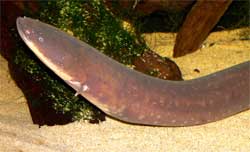|
The electric eel (Electrophorus electricus) is a species of fish. It is capable of generating powerful electric shocks of up to 600 volts, which it uses for both hunting and self-defense. It is a top predator in its South American range. Despite its name it is not an eel at all but rather a knifefish.
The electric eel may be found in the basins of both the Amazon River and Orinoco River, as well as the surrounding areas. It can grow up to 2.5 m in length and 20 kg in weight, although 1 m specimens are more common. A typical example will have an elongated cylindrical body bearing only a few scales, a flattened head and an overall dark grayish green color shifting to yellowish on the bottom.
They tend to live on muddy bottoms in calm water and are obligate air-breathers; rising to the surface every 10 minutes or so, the animal will gulp air before returning to the bottom.
The electric eel generates its characteristic electrical pulse in a manner similar to a battery, in which stacked plates produce an electrical charge. In the electric eel, some 5,000 to 6,000 stacked electroplaques are capable of producing a shock at up to 500 volts and 1 ampere of current (500 watts). There are reports of animals producing larger voltages, but the typical output is sufficient to stun or deter virtually any other animal. Juveniles produce smaller voltages (about 100 volts). Electric eels are capable of varying the intensity of the electrical discharge, using lower discharges for "hunting" and higher intensities are used for stunning prey, or defending themselves. When agitated, it is capable of producing these intermittent electrical shocks over a period of at least an hour without signs of tiring. The exact mechanism remains largely unknown. The species is of some interest to researchers, who make use of its acetylcholinesterase and ATP.
Similar species are the electric catfish (Malapterurus electricus) and the electric ray (Torpedo mamorata, T. californica).
Although the eels are common in their range and popular draws for public aquaria, the eel's habit of delivering shocks, even when gently handled, means that they are too dangerous for most amateurs to try to keep at home. Moreover, the animals grow very large, and are impossible to maintain for all but the most dedicated of keepers. Countries such as Australia strictly forbid the keeping of electric eels, for fear that they could escape into the wild and become a public hazard.
The species is so unusual that it has been reclassified several times. Originally a species in Gymnotus, it was later given its own family Electrophoridae, and then demoted to a genus of Gymnotidae alongside Gymnotus.

 Electric eels can grow up to 2.5 m (about 8.2 feet) in length and 20 kg (about 44 pounds) in weight, although 1 m specimens are more common. A typical example will have an elongated, cylindrical body bearing only a few scales, a flattened head, and an overall dark Electric eels can grow up to 2.5 m (about 8.2 feet) in length and 20 kg (about 44 pounds) in weight, although 1 m specimens are more common. A typical example will have an elongated, cylindrical body bearing only a few scales, a flattened head, and an overall dark
grayish green color shifting to yellowish
on the bottom.

Who Needs Gills? The electric eel may be found in the basins of both the Amazon River and Orinoco River, as well as the surrounding areas. They tend to live on muddy bottoms in calm water and are obligate air-breathers; rising to the surface every 10 minutes or so, the animal will gulp air before returning to the bottom. Nearly 80% of the oxygen used by the fish is taken in this way.
Good Hearing: Scientists have been able to determine through experimental information that E. electricus has a well developed sense of sound. They have a Weberian apparatus that connects the ear to the swim bladder, which greatly enhances their hearing capability.
 Bathing Battery: The electric eel generates its characteristic electrical pulse in a manner similar to a battery, in which stacked plates produce an electrical charge. In the electric eel, some 5,000 to 6,000 stacked electroplaques are capable of producing a shock at up to 500 volts and 1 ampere of current (500 watts). There are reports of animals producing larger voltages, but the typical output is sufficient to stun or deter virtually any other animal. Juveniles produce smaller voltages (about 100 volts). Electric eels are capable of varying the intensity of the electrical discharge, using lower discharges for "hunting" and higher intensities are used for stunning prey, or defending themselves. When agitated, it is capable of producing these intermittent electrical shocks over a period of at least an hour without signs of tiring. The exact mechanism remains largely unknown. Bathing Battery: The electric eel generates its characteristic electrical pulse in a manner similar to a battery, in which stacked plates produce an electrical charge. In the electric eel, some 5,000 to 6,000 stacked electroplaques are capable of producing a shock at up to 500 volts and 1 ampere of current (500 watts). There are reports of animals producing larger voltages, but the typical output is sufficient to stun or deter virtually any other animal. Juveniles produce smaller voltages (about 100 volts). Electric eels are capable of varying the intensity of the electrical discharge, using lower discharges for "hunting" and higher intensities are used for stunning prey, or defending themselves. When agitated, it is capable of producing these intermittent electrical shocks over a period of at least an hour without signs of tiring. The exact mechanism remains largely unknown.

The Sachs organ, a stack of electroplaques, is the primary source of communication among E. electricus. This organ transmits a weak signal, only about 10V in amplitude. These signals are used in communication as well as orientation, and are used to find prey and locate and choose a mate.

Although the eels are common in their range and popular draws for public aquaria, the eel's habit of delivering shocks, even when gently handled, means that they are too dangerous for most amateurs to try to keep at home. Moreover, the animals grow very large, and are impossible to maintain for all but the most dedicated of keepers. Countries such as Australia strictly forbid the keeping of electric eels, for fear that they could escape into the wild and become a public hazard.
The species is so unusual that it has been reclassified several times. Originally a species in Gymnotus, it was later given its own family Electrophoridae, and then demoted to a genus of Gymnotidae alongside Gymnotus.
Similar species are the electric catfish (Malapterurus electricus) and the electric ray (Torpedo mamorata, T. californica).
All text is available under the terms
of the GNU Free Documentation License
|

